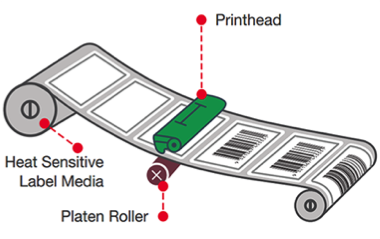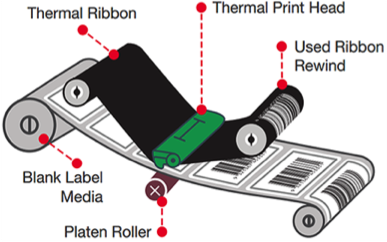The difference between direct thermal and thermal transfer printing

We place before the user, the information that you need to know, for perfect label quality and printing. This piece of article helps you all, to know most of the key aspects about direct thermal and thermal transfer printing. Both Thermal Printers and Thermal Transfer Printers are capable to produce barcode labels which are high-quality images with excellent edge definition and that the barcode scanners capture data successfully.
These printers can print both linear and two-dimensional barcodes such as data-matrix or QR Codes, text and graphics with either thermal printing method.
Let us look at the similarities at first:
Both printing technologies involve the key component, thermal print head that applies heat to the surface media material in contact. The general term thermal printer may be used for direct thermal label printers as well as for thermal transfer printers. Their printing resolution is specified in dots per inch (dpi). It is usually 203, 300 or 600 dpi. The higher the number of dpi and that relates to higher print resolution and print quality.
The actual difference between the two methods is in the surface that is heated by the thermal printhead.
Direct thermal printing heat directly the labels (heat-sensitive) that is in direct contact with the printhead and turns the label with the print image.
Conversely, Thermal transfer printing uses a wax- or resin-based ribbon that comes in contact with the printhead, when heated, it transfers ink onto the label.
How does a direct thermal label printer work?
The label with a heat-sensitive coating comes in direct contact with the heating element, thermal printhead which apply punctual heat to the passing label.

The heat and chemical reaction causes the label to change colour from white to black and create the image.
How does a thermal transfer printer work?
In thermal transfer printing, the paper label which passes between heat transferring thermal head and the wax or wax resin ribbon. The printhead which is an heating element that apply punctual heat to the passing ribbon, thus causing it to melt onto the label and form the print image.

Each industry and within the organization, each use-case needs different label stock (label and adhesive) and ribbon (wax or wax resin or resin) in order to achieve optimum print quality and durability. One must choose the label and ribbon media with respect to printing speed of the printer.
A comparison table below supports the user to choose the printing method and printer
| Direct thermal | Thermal transfer | |
| Print quality | Good readability and Scannability | Supreme readability and Scannability |
| Print durability | Particularly and extremely sensitive to heat, light and other environmental conditions (label will darken when overexposed and suffer Scannability) | Long-life image stability |
| Colour printing | Only black and white | Single Colour Printing with coloured ribbon |
| Print head life | As the print head is in direct contact with abrasive labels which presents wear-out. This necessitates the printhead replacement and increases the cost. | Higher life due to the mechanism that the ribbon (with back-coating) acts as buffer between print head and label material which reduces static and friction. |
| Printer configuration and maintenance | Simple to operate, because no ribbon required and less moving parts due to absence of ribbon holding and rotation modules. Less maintenance cost. | · The printer downtime is more due to ribbon changes, parts cleaning and adjustments. · Can print on variety of label media such as polyester and synthetic. |
| Media selection and cost | Higher cost for direct thermal labels | Generally the media cost is lower and needs a careful choice of media depending the use-case. |
| Typical applications | Shipping labels, receipts, tickets | Product and packaging labels, GHS labels, asset tags |
Conclusion
A thermal transfer printing supports durable and high-resolution images, and greatly in demand for traceability applications and where labels are exposed to harsh conditions such as chemicals, sunlight and open-area exposures
A short shelf-life labelling application goes well with direct thermal printing and makes a business sense with simple and cost-effective choice.


